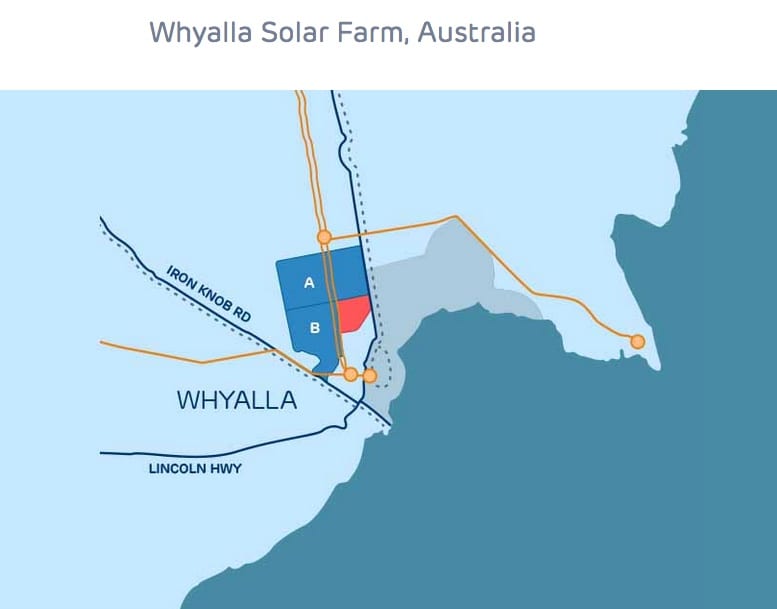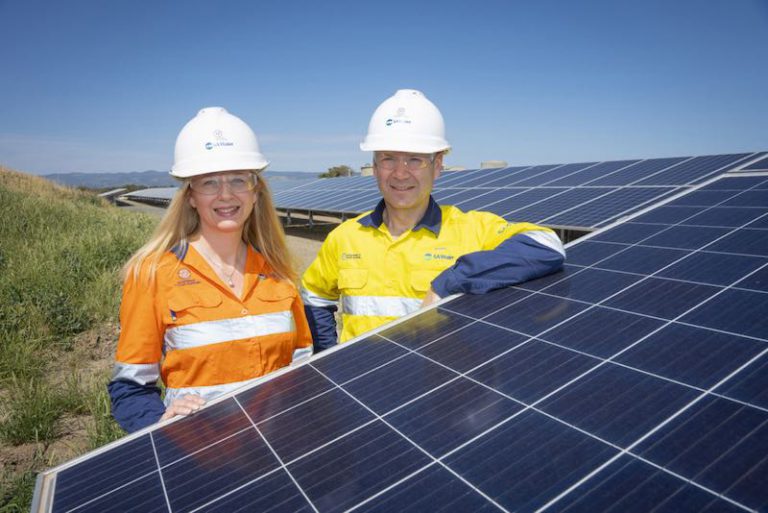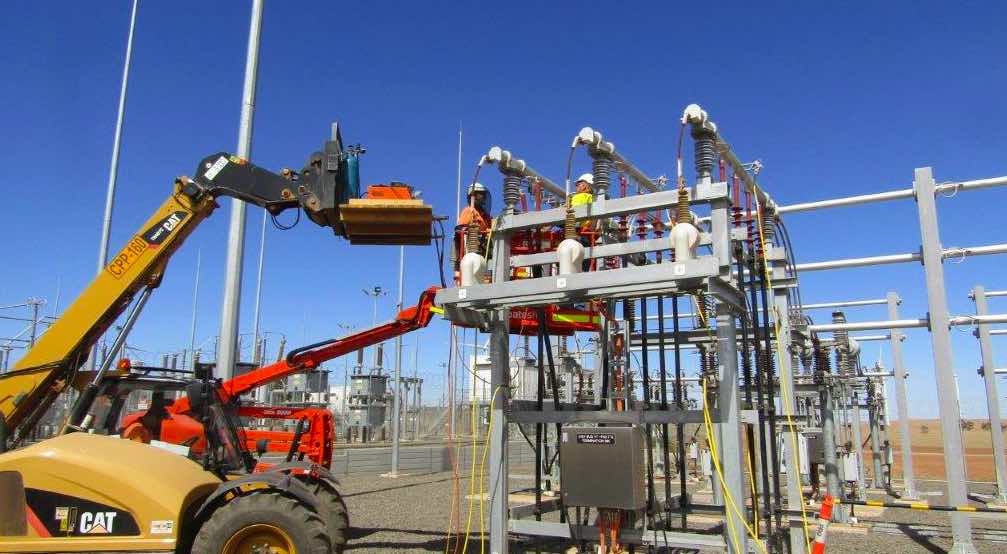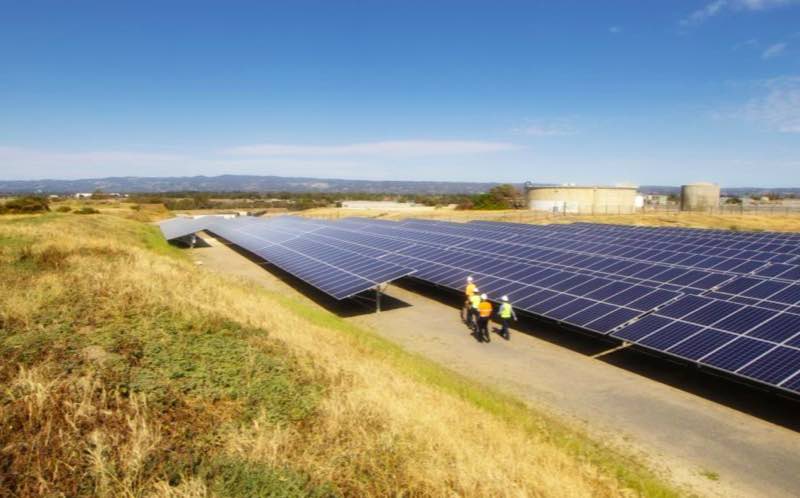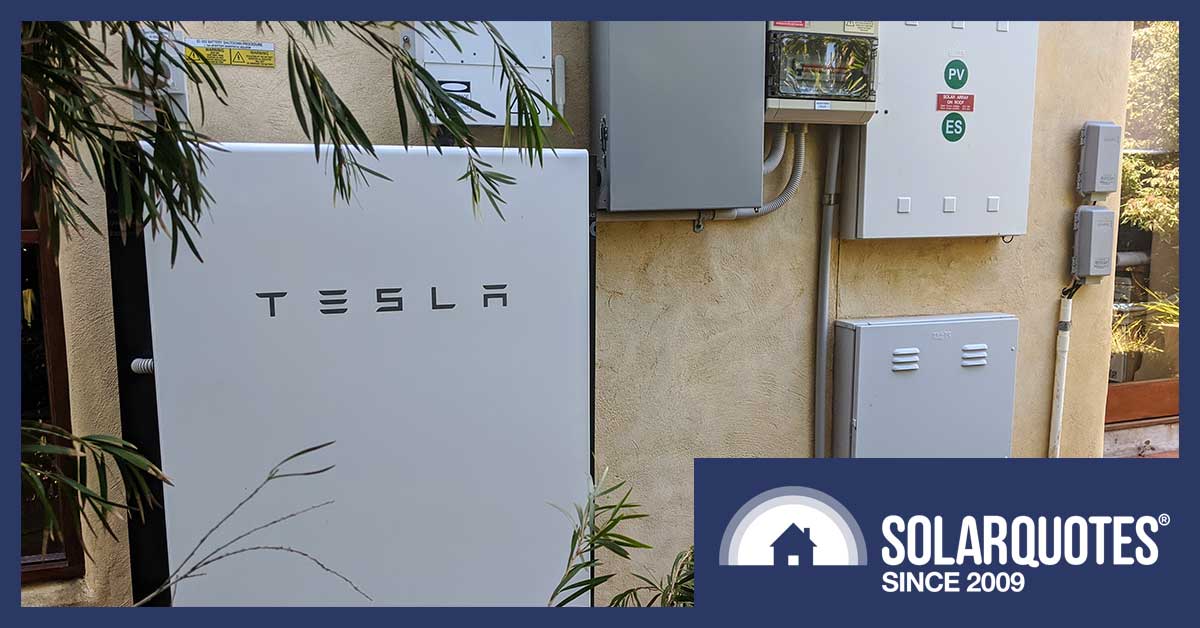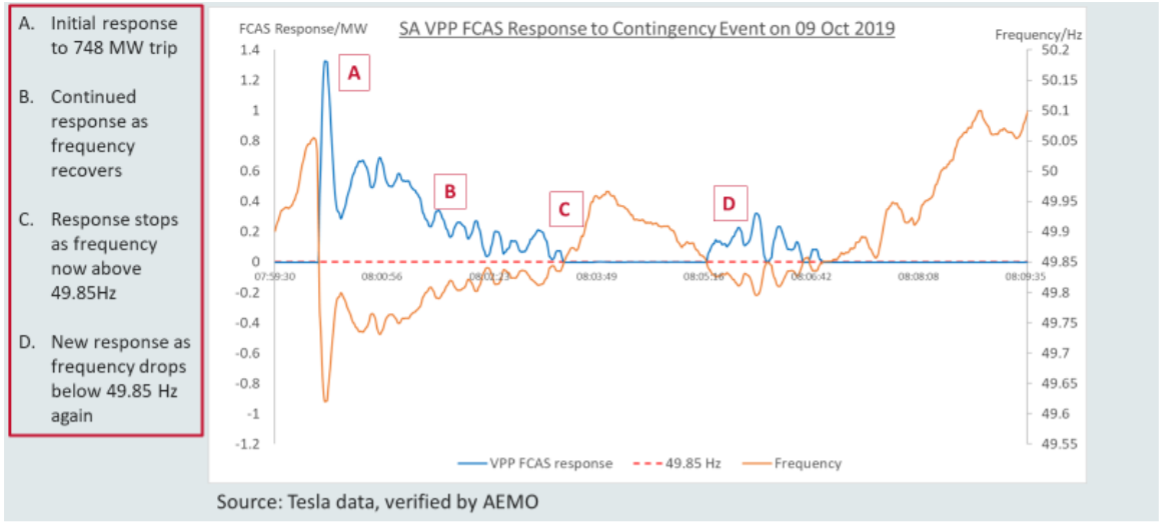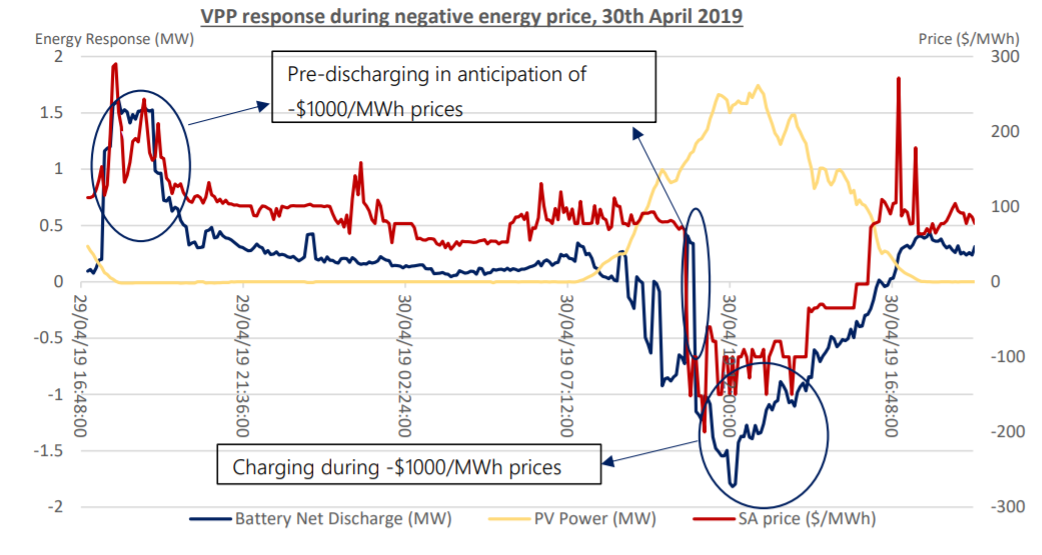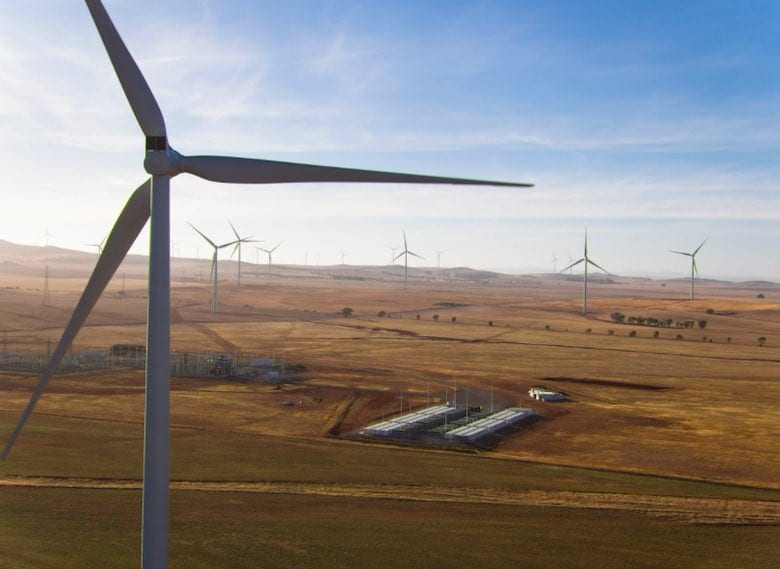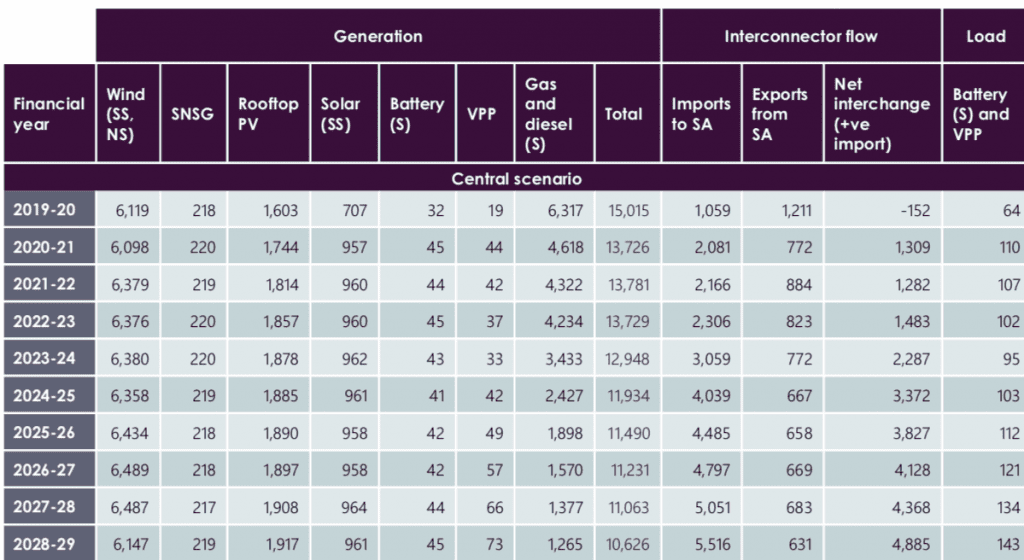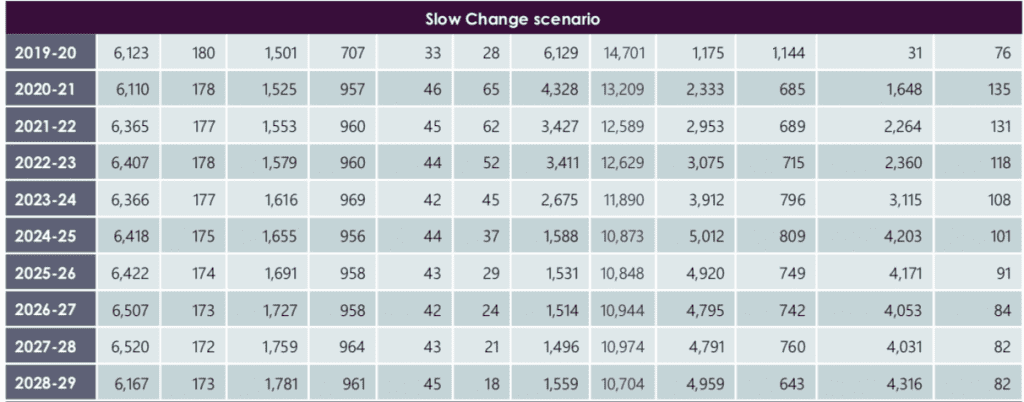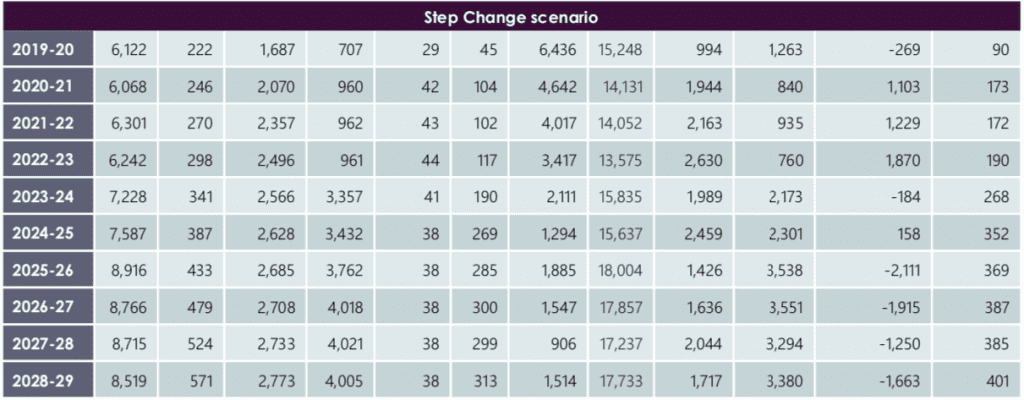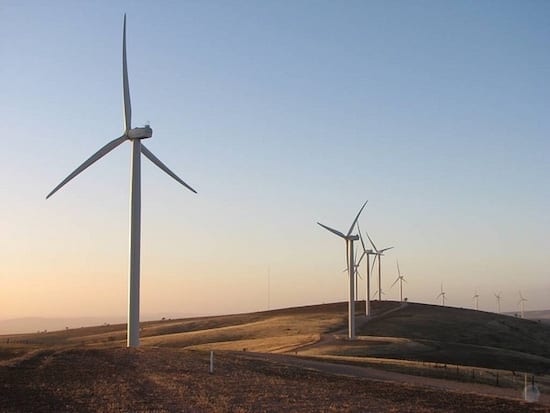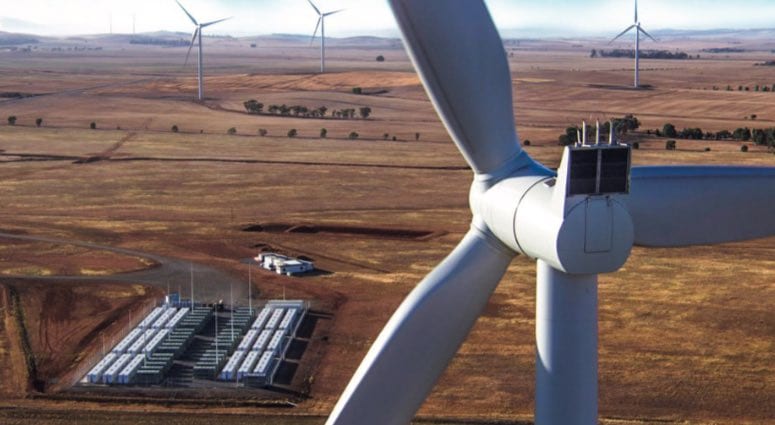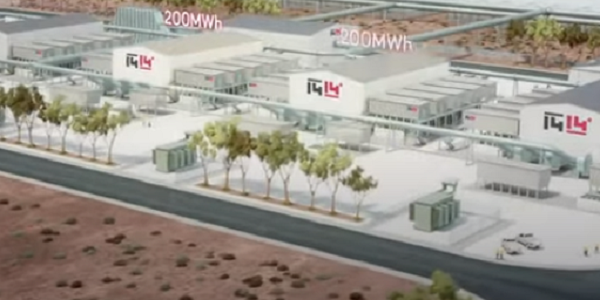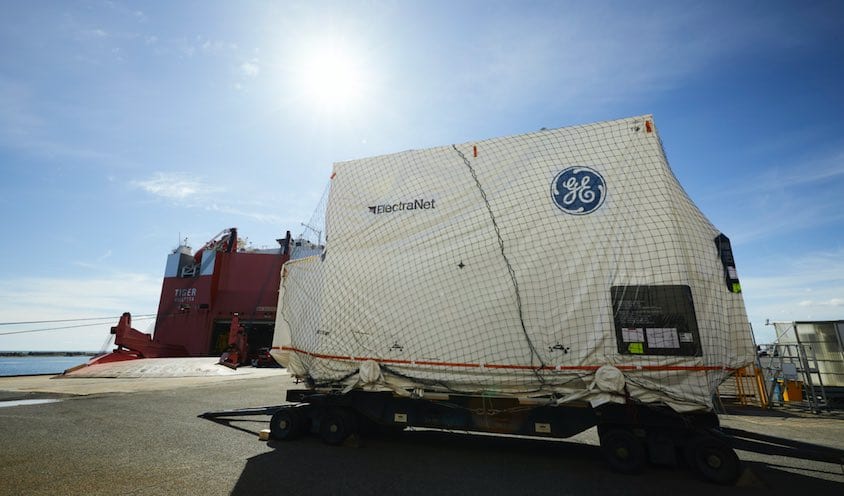News & Discussion: Electricity Infrastructure
-
how good is he
- Legendary Member!
- Posts: 1233
- Joined: Thu Jan 24, 2013 1:26 am
Re: News & Discussion: Electricity Infrastructure
Impressed that they mention SAs Hornsdale Reserve as ground breaking in this publication, so hopefully more people know this about it in the USA & globally. I forget that SA and little old Jamestown holds the current world record for something so relevant today.
Re: News & Discussion: Electricity Infrastructure
Adani re-applying for a licence to develop a solar farm at Whyalla (after telling the state government that if the Gupta solar farm went ahead, it would endanger wildlife!)
From Renew Economy
From Renew Economy
Adani Renewables applies – again – for Whyalla solar farm generation licence
Adani Renewables’ ongoing bid for regulatory approval for its long-delayed 140MW Whyalla solar farm in South Australia is back in the lap of the state’s Essential Services Commission after an updated application for an electricity generation licence was submitted on Wednesday.
The updated application – the original was submitted all the way back in November of 2018 – was submitted by fully-owned Adani subsidiary Whyalla Renewables, and seeks a licence to operate the Whyalla solar power generator starting next month.
“Licence to Operate the Whyalla Solar Farm is sought from 15th of April 2020, as we require certainty for the project,” the application says.
“Also the Licence is a pre-requisite to AEMO (Australian Energy Market Operator) registration, therefore, we require the licence and finalised technical conditions from ESCOSA to finalise the GPS and AEMO Registration,” it adds.
The amended application appears to change the project “contact person” nominated by Whyalla Renewables, and the date sought for the licence, which was originally set at a hopeful December 04, 2018. The new application again states the project has no battery storage planned.
And while all necessary approvals for construction were finalised last year, lingering uncertainty around grid connection and off-take partners has kept the $200 million project in limbo.
The project would be located close to the Whyalla Steelworks, which was bought by UK billionaire Sanjeev Gupta, who intends to construct a total of 1GW of solar and storage to reduce the plant’s energy costs, and for other major energy users in the state.
And in an ironical twist to the tale, Adani – which is also the proponent of the highly controversial Carmichael coal project in Queensland’s Galilee Basin – in April last year raised objections to one of Gupta’s Whyalla solar projects, citing concern over the impact on two bird species.
The objection, revealed in planning documents filed to South Australia’s State Planning Commission, referred to the 280MW Cultana solar farm, designed to provide power to the Whyalla Steelworks, and located right next to the Adani Renewables project.
Whether this comes back to bite the company remains to be seen – the new application will be subject to a public consultation and submissions period closing on April 09, 2020.
https://reneweconomy.com.au/adani-renew ... nce-60982/
Re: News & Discussion: Electricity Infrastructure
SA Water is ploughing ahead with its building program of small solar farms (with battery storage) next to pumping stations, to cut its electricity bill.
From One Step Off The Grid
From One Step Off The Grid
SA Water readies to install another 8MW solar, 880kWh battery storage
SA Water looks to be making a start on its big plans for solar and storage in 2020, with an application to the South Australia regulator to install 8MW of solar and 750kW/880kWh of battery storage at its Swan Reach Water Treatment Plan, north-east of Adelaide.
The utility, one of the state’s largest energy users, has submitted an application for a variation to its electricity generation licence, to the South Australian Essential Services Commission.
The application seeks approval for multiple new generating plant locations, including a 2.5MW solar array at the Swan Reach 1 pumping station, 4.95MW of solar at the Swan Reach 2 pumping station, and 550kW of PV at the Swan Reach water filtration plant.
The application also seeks a licence to install a 750kW/880kWh Tesla battery storage system at the Swan Reach water pumping station.
The new installations are part of SA Water’s journey to “net zero” electricity costs, which it had aimed to achieve this year by rolling out a total of 154MW of solar PV and 34MWh of energy storage across more than 70 of its sites in a plan first unveiled in December 2017.
The huge task has been undertaken in partnership with Adelaide-based Enerven – a wholly-owned subsidiary of SA Power Networks – which won the tender for the massive contract in 2018, including plans for a floating solar plant.
SA Water manages more than 27,000km of water mains, including 9,266 km in the Adelaide metropolitan area. In 2016-17, the utility’s electricity bills totalled $55 million for 220GWh and $62 million in 2017-18.
“Locating generation behind the meter will improve our resilience to grid interruptions, significantly reduce our network charges and isolate our business from electricity market price volatility, in both the short and long-term,” SA Water’s head of “Zero Cost Energy Future” Nicola Murphy said in January.
“We’ll always need to use and buy some electricity, but we can be smart in our approach to managing it as we work towards a zero cost energy future.”
https://onestepoffthegrid.com.au/sa-wat ... y-storage/
Re: News & Discussion: Electricity Infrastructure
Slightly off-topic, but where have OHS rules taken us that these people need hard hats and clear safety glasses, but it's OK for one to have long loose hair and a pendant on a chain round her neck not tucked behind a tee-shirt?PeFe wrote: ↑Tue Mar 17, 2020 12:48 pmSA Water is ploughing ahead with its building program of small solar farms (with battery storage) next to pumping stations, to cut its electricity bill.
From One Step Off The Grid
SA Water readies to install another 8MW solar, 880kWh battery storage
...
https://onestepoffthegrid.com.au/sa-wat ... y-storage/
Re: News & Discussion: Electricity Infrastructure
Neoen has completed the expansion of the Tesla big battery, now comes the testing and compliance phase.
From Renew Economy
From Renew Economy
Neoen says network connection complete at expanded Tesla big battery
French renewable energy developer Neoen says the network connection at the expanded Hornsdale Power Reserve (also known as the Tesla big battery) are now complete, and the world’s biggest lithium-ion battery installation will soon be able to offer new services to the grid.
Neoen Australia managing director Louis de Sambucy said in a post on his LinkedIn profile last week that the network connection for the expanded battery – which will grow from 100MW/129MWH to 150MW/194MWh – had been finished.
“The world’s biggest battery to provide soon extra reliability to the grid in those extremely challenging times (very low demand, increased risks of outages,” he wrote in the brief post, including the image above, and adding his congratulations to the teams from contractors CPP, Tesla and Neoen.
As RenewEconomy has reported, in some detail, the expanded battery will provide key services such as digital or “virtual” inertia with the expanded battery, which if successful will represent another key piece of the market that can be assumed by big batteries such as Hornsdale, allow yet more renewables and provide more reason to reduce the dependence on gas generators.
Neoen said at the time the inertia benefits – dubbed by Tesla as its Virtual Machine Mode (VMM) – would facilitate the transition towards a high-penetration renewable grid. In South Australia, the state Liberal government has a target of “net 100 per cent renewables’ by around 2030.
It will need to wait for final approval from the South Australia energy regulator, and commissioning its the local network owner and the Australian Energy Market Operator before it is switched on, but that is expected before the end of June.
The Tesla big battery has already played a key role in enhancing grid reliability and security, making money for its owners, Neoen, and delivering an estimated $150 million in savings to consumers, largely through reduced costs of frequency control and ancillary services, a market traditionally dominated and controlled by the gas generators.
Neoen is also working with Tesla on a 20MW/34MWh battery at the Bulgana energy hub in Victoria, where it will provide a 100 per cent renewable power source to the proposed new giant vegetable glasshouse to be built by Nectar Farms.
Neoen and Tesla are also likely to work together on an even bigger project should Neoen win an upcoming tender to lift the capacity of the main transmission link from Victoria to NSW.
Neoen has proposed a 600MW battery, dubbed the “Victoria big battery” and has filed for a planning application with the Geelong City Council for an installation at Ausnet’s Moorabool terminal.
Neoen says it has not yet finalised a product provider, but the planning documents cite as an example the use of Tesla’s new “megapack”, which have about 1.5MW of capacity and 3MWh of storage – about 15 times bigger than the Powerpacks used at Hornsdale.
That would potentially deliver a battery the size of 600MW/1200MWh, meaning that much of the battery’s capability could be used for purposes other than the transmission capacity upgrade.
https://reneweconomy.com.au/neoen-says- ... ery-26299/
Re: News & Discussion: Electricity Infrastructure
SA Water is building a small solar farm next to the Adelaide desalination plant at Port Stanvac. Desalination plants are incredibly energy hungry (when they are running)
From Renew Economy
From Renew Economy
SA Water to build solar farm on former oil refinery site
Nothing says energy transition quite like a renewable energy facility being built on an old fossil fuel asset. Solar farms have been built on or near several old coal plants, and now the South Australia state government utility SA Water plans to build a new solar farm with more than 35,000 solar PV panels on the site of a former oil refinery.
SA Water said on Thursday that it has agreed to purchase 14 hectares of land at the former ExxonMobil Port Stanvac oil refinery, next to the Adelaide Desalination Plant which the solar farm will help power. and as part of the utility’s push to a “zero cost energy future” that involves more than 150MW of solar across dozens of sites, and 34 megawatt hours of battery storage.
The ExxonMobil refinery was closed in 2003 and demolished in 2014, and the overall 240 hectare site is being remediated to pave the way for other industry activity.
“The site will see a complete turnaround from facilitating a traditional energy source to housing renewable energy resources that will reduce our carbon emissions by 10,710 tonnes per year,” said Nicola Murphy, the head of SA Water’s Zero Cot Energy Future division.
“Solar panels are already being installed on our existing land across the road at the Adelaide Desalination Plant and we’re hoping to start construction on this new site in mid-2020.”
The new solar farm will feature fixed-tilt racking systems and is expected to generate an average total of 21 gigawatt hours (GWh) of electricity per year, which combined with a battery storage system will offset around half the plant’s energy costs, and sometimes produce more than required.
“During high production mode the combined solar generation and battery storage will offset around 50% of the plant’s energy costs, with the facility’s existing hydro turbines making additional smaller contributions,” Murphy said.
“In times of higher rainfall when the plant operates in a lower production mode, the combined solar generation and battery storage will provide more energy than the facility requires and return the excess to the National Electricity Market.”
SA Water is one of the largest single electricity consumers in the state, and its drinking water and wastewater pumping and treatment operations throughout a dry 2018/19 cost $83 million.
In all, SA Water plans to install more than 500,000 solar panels across 37 of its sites across the state to produce 242 GWh of electricity, along with 34 megawatt hours of battery storage.
“The desalination process requires a significant amount of energy, so putting more focus on our own energy generation will reduce our overall draw on the local electricity grid, allowing us to better manage operating costs,” Nicola said.
“We will still need to draw electricity from the grid, but we’ll offset those costs by storing and selling energy we produce at other times.
SA Water has already installed about 130,000 solar panels located at sites like the Bolivar Wastewater Treatment Plant and major pump stations along the Morgan to Whyalla Pipeline, and a number of roof and ground-mounted smaller sites across the state, with the remaining panels due to be installed before the end of the year.
https://reneweconomy.com.au/sa-water-to ... ite-30551/
Re: News & Discussion: Electricity Infrastructure
Article detailing the VPPs (that's Virtual Power Plants in case you didn't know) interaction with the electricity grid during events that disrupt electricity supply.
From Solar Quotes Blog
From Solar Quotes Blog
AEMO Judgement On SA VPPs: Yes, They Help The Grid And Turn A Profit
The Tesla VPP in South Australia networks thousands of residential Powerwall batteries to work together, support the grid and make money. How did it go in its first 12 months? Pretty good.
South Australia’s Virtual Power Plant isn’t just delivering electricity to consumers in that state – it’s also proven successful at helping the SA grid respond to grid-scale events. And that grid-response is a profitable sideline for the VPP.
That’s the conclusion offered in this AEMO paper, an analysis of the VPP’s performance when the SA grid was under stress.
The five events in question happened between April 2019 and January 2020. Three required emergency Frequency Control Ancillary Service (FCAS) responses to keep the grid’s frequency within spec, while the other two were events which, in the AEMO’s language,
“required an energy response”
(the VPP had to respond to energy market signals – price rises and falls).
The analysis focuses on the Energy Locals / Tesla VPP, and it found grid stabilisation was a handy revenue generator for the project, with $132,000 revenue from large contingency FCAS events, and $126,000 from lower contingency FCAS events.
Where Does A VPP Fit In The Grid?
There are currently three VPPs in operation in Australia’s grid, all in South Australia (we’ve listed them here). As we explained when we first published our VPP comparison table, the idea is pretty simple: participants allow the VPP operator to take over control of their battery, in exchange for the chance to buy and sell grid electricity at wholesale, rather than retail, prices.
The operator then gets to charge or discharge the batteries in response to what’s going on in the grid. If there’s a power shortage, the batteries discharge; if there’s an excess on the grid, the operator feeds the cheap power into the batteries.
That makes a VPP potentially important in an increasingly renewable world in which the grid has less “big spinning iron” to help stabilise grid frequency, and in which there can be big changes in supply with increases or falls in sunshine or wind.
VPP And Frequency Stabilisation
The three times SA’s grid needed FCAS were when:
Queensland’s Kogan Creek generator tripped in October 2019 taking 748MW out of the power system (the grid went below frequency);
when the interconnect between Victoria and South Australia was disconnected in November 2019 (the grid frequency rose); and
over- and under-frequency events in December 2019.
The VPP wasn’t perfect – it only met the grid’s requirement in two out of the three events. In the October 2019 Kogan Creek event, and in the over-and-under frequency event in January 2020, the VPP exchanged power with the grid as required. The image below, for example, shows the VPP pumping power into the grid whenever the frequency dropped below 49.85Hz.
VPP performance during the Kogan Creek outage. Source: AEMO
Things didn’t go as well in November 2019, when what AEMO calls
“a non-credible contingency event resulted in the electrical disconnection of the South Australian region from the rest of the NEM power system for nearly five hours”.
What non-credible contingency event? In this AEMO report, it’s attributed to the
“maloperation of a communication multiplexer which caused the X unit protections on both of the affected transmission lines to erroneously detect faults and cause the opening of circuit breakers at each terminal”.
The transmission lines affected were both 500kV links from Heywood – one headed for Mortake, the other to Tarrone.
AEMO describes the VPP’s response like this: “The initial separation resulted in the power system’s frequency reaching 50.85 Hz3, which meant the SA VPP was required to deliver its full amount enabled, 1 MW lower contingency FCAS. In this example, the SA VPP under-delivered FCAS.”
This was not, however, a failure of the VPP as a concept – it was a configuration issue. Quite simply, not all the Tesla batteries in the Energy Locals VPP “had the appropriate frequency support settings enabled”, so instead of having 1MW available to provide FCAS, there was only 828kW. Because the batteries are under the provider’s control, Energy Locals was able to remotely reconfigure the “non-compliant systems”, and since then Tesla has been checking systems daily to make sure they will respond to future events.
Market Signals
The two energy market events in the analysis were in 30 April 2019, a negative pricing event; and a week of fluctuating prices starting on 9 January 2020.
The April negative price event happened before the VPP Demonstration formally began operation. The price dipped below zero twice, on 29 and 30 April, and AEMO’s chart shows the batteries responding to the events. The VPP offered a similar response in January, stabilising prices by charging when electricity is cheap, and discharging when prices spiked.
The VPP responding to January’s price fluctuations. Source: AEMO
https://www.solarquotes.com.au/blog/aemo-report-vpp/
Re: News & Discussion: Electricity Infrastructure
Article from Renew Economy speculating on future pathway to 100% renewable energy.
One detail from the article I disagree with is their assertion that South Australia will become a net electricity exporter in the near future... well from other reports I have seen (and posted on this site last year) South Australia has been a net exporter of electricity for the last 2 years....in fact business plans for solar and wind farms in SA would be to factor in the ability to export electricity east via the Heywood Connector and hopefully the soon to be built NSW interconnector.
One detail from the article I disagree with is their assertion that South Australia will become a net electricity exporter in the near future... well from other reports I have seen (and posted on this site last year) South Australia has been a net exporter of electricity for the last 2 years....in fact business plans for solar and wind farms in SA would be to factor in the ability to export electricity east via the Heywood Connector and hopefully the soon to be built NSW interconnector.
South Australia could reach stunning 87 per cent wind and solar in four years
South Australia – already leading the country, if not the world, with the amount of wind and solar in its electricity grid – could reach a level of 87 per cent renewables within four years, according to the latest scenarios published by the Australian Energy Market Operator.
The AEMO document outlines three core scenarios on how the South Australia generation mix could change over the next 10 years – a central scenario based on current policy settings and known investment commitments, a slow change based on slow economic growth and disinterest in emissions reduction, and a “step change” where real efforts and investment are made to reduce emissions.
South Australia already sources more than 50 per cent of its generation from wind and solar – the highest percentage of “variable” renewable sources in Australia by a long shot, and bettered only by Denmark in the world. South Australia, however, is at the end of a long skinny grid with a single connection to the neighbouring grid, putting its share of renewables at the world’s leading edge.
The AEMO report assumes that the state will source around 57 per cent of its generation from wind and solar in the current financial year, and dials in the addition of the Lincoln Gap battery, the second stage of the Lincoln Gap wind farm, and the retirement of several ageing gas units in coming years.
But it is the proposed new interconnector (Project Connect) to NSW from June 2023 that act as the “game-changer” for the state’s generation mix. Either way, the outlook for local gas generation is not good – it is either rapidly replaced by imports from NSW under the “central scenario” or replaced by big leaps of wind and large and small scale solar in the “step change” scenario.
In the step change scenario, the addition of the new interconnector encourages a massive amount of new build wind and solar, and an increased update of distributed energy resources (DER) that takes the share of wind and solar to 87 per cent of the state’s generation by 2023/24.
It relegates gas and diesel to a minor share of just 13 per cent, and with the level of imports and exports to Victoria and NSW about equal.
Over the following few years, the share of renewables continues to grow – about 1,200MW of large scale solar will be added and a further 1277MW in large scale wind.
This means that by the 2027/28 financial year, gas contributes little more than just 5 per cent of total generation in the state. Wind and solar provide the rest – augmented by big batteries and “virtual power plants” (linked household batteries), but with more than 20 per cent of their combined output being exported.
In other words, wind and solar will be producing much more than the state’s annual consumption needs, and the excess will be exported, with some imports (less than one half of the exports), and the gas generators providing “back-up” when needed. “South Australia ends up as a net exporter on its interconnectors for the last few years of the forecast,” the report says.
That puts the state well within the Liberal state government’s unofficial target of reaching “net 100 per cent” renewables by around 2030. it suggests its longer term targets of becoming a “net exporter” are also within reach in that time-frame.
Even in the slow change and central scenarios, gas only accounts for no more than 15 per cent of local generation by 2028/29. The difference with “step change” is that imports account for nearly one third of demand in slow change and central, while local wind and solar – and exports – make up the difference in step change.
Another interesting aspect of the Step change scenario is the growing impact of “virtual power plants” – currently being rolled out in the state-government’s Home Battery Scheme and other proposals. According to AEMO, VPPs could account for more than eight time the output of big batteries by 2028/29.
So much so that in the step change scenario AEMO notes that “consumer-led growth of storage creates such an abundance of VPP that its market utilisation begins to lag installed capacity.”
https://reneweconomy.com.au/south-austr ... ars-11675/
Re: News & Discussion: Electricity Infrastructure
Another article from Renew Economy discussing South Australia's pathway to 100% renewable energy.
South Australia could meet state Liberals’ 100 pct renewables target 5 years early
It’s not by chance that the two states in Australia with the most ambitious renewable energy policies – Tasmania and South Australia – are the ones without a coal industry in their backyard.
And that probably explains the second, more surprising observation, which is that both the Tasmania target – 200 per cent renewables by 2040 – and the South Australia target – net 100 per cent wind and solar by around 2030 – have been set by state Liberal governments. Both states have grand ambitious to be significant exporters of excess renewables output.
It would be nice to think that the federal Liberal Party could share a similar vision. But whether clouded by the interests of ideologues or donors, or the fossil fuel industry, the federal Coalition won’t contemplate the idea that a renewables based grid could be made to work. Like a petulant child struggling with Lego blocks, it can’t imagine what the finished product might be.
South Australia is happy to show them, Having closed down its coal plant in 2016, and supported the introduction of the country’s first big battery in 2017, the state has arguably the country’s most reliable grid, and in the last six months one of the cheapest on the wholesale market. And it is producing well in excess of 50 per cent of its electricity consumption from wind and solar.
Pretty soon, it might be providing the equivalent of close to 100 per cent of its electricity consumption from variable renewables, even allowing for the times when the wind don’t blow and the sun don’t shine.
The state Liberal government aims to reach “net 100 per cent renewables” – effectively producing the annual equivalent of its consumption with wind and solar, and using a new link to NSW to help it export the excess, and import when needed – by around 2030.
The latest report from the Australian Energy Market Operator, however, indicates that it might reach that target by 2025/26, five years earlier than planned. (The South Australia government, be it Labor or Liberal, has a long history of setting aspirational renewable targets that will likely be easily met).
As we reported on Monday, the latest AEMO generation forecasts suggest that the proposed Project EnergyConnect – a new 800MW link from South Australia to NSW – will be something of a game-changer, and in its step-change scenario (one of three contemplated in the report), it sparks an almost immediate boom in large scale wind and solar projects, along with storage.
Within four years, as we wrote, the share of wind and solar in the generation mix balloons to 87 per cent, and the share of gas falls to a range of 5-15 per cent, depending on the scenario – slow, central and step change – and the amount of imports or exports on the new link.
Closer inspection of the AEMO forecast data suggests that the net 100 per cent renewable energy target could be met by 2025/26 in the step change scenario – and this scenario is crucial if the state is not to suddenly find itself becoming a net importer rather than an exporter of electricity.
The AEMO data shows that in this step change scenario – which combines infrastructure spending, digitalisation, and consumer innovation – wind and solar and stored power – in big batteries and household virtual power plants – will contribute more than 15,800GWh a year, a 60 per cent increase from this year,
Gas will provide around 1,888GWh, a fall of more than two thirds – so even if all the imports from NSW were deemed to be “fossil fuel”, they would be more than offset by South Australia’ net exports of 2,111GWh.
That’s going to be an extraordinary achievement, and one that will change the conversation around energy in Australia, and the world. Let’s remember, it was around a decade ago that energy analysts insisted that a 10 per cent share of wind and solar was impossible. Some till claim that it must not exceed 50 per cent at any point in time, even though that already happens nearly every day in South Australia.
Credit for this achievement will have to go to the Labor government that set the plan in motion (although it continues to fiercely dispute the wisdom of a new interconnector), and the Liberal government that succeeded it which looked at the science, the engineering and the maths, ignored its federal colleagues, and said: “Let’s do it!”.
State energy minister Dan van Holst Pellekaan is not getting too carried away.
“AEMO’s report shows that on a range of future scenarios South Australia is making huge progress towards our aim of net-100% renewables as close to 2030 as possible,” he said in a statement emailed to RenewEconomy.
“The SA-NSW interconnector will be critical in driving a step change in renewable energy to secure clean, affordable, reliable power for South Australian households and businesses.”
“There is strong interest from energy companies considering investing in renewable generation in South Australia on the back of the interconnector.”
These projects are not specified by AEMO (apart from the more immediate completion of the much delayed 110MW Bungala 2 solar plant and the second 230MW stage of the Lincoln Gap wind project, both near Port Augusta), but the queue of potential projects are not hard to find and are already jostling for position.
There is Alinta, the owner of the state’s last coal plant near Port Augusta, which has already signed a contract to take the output of the proposed 200MW Solar River solar and very big battery plans near Robertstown.
That project will be surrounded by other big projects ousting for position near the western end of the proposed new link, including the even bigger Robertstown solar farm, and other projects such as Neoen’s Crystal Brook (combing wind, solar, batteries and a hydrogen fuel cell), and its massive Goyder South wind, solar and battery project, along with Sanjeev Gupta’s ongoing plans for the Cultana solar farm and Playford big battery.
There is also the 280MW Bungama solar plant, also with a big battery, proposed for near Port Pirie, while Spanish energy giant Iberdrola has teamed up with DP Enegy for a 320MW hybrid wind and solar plant near Port Augusta, which already has its finances lined up.
All in all, AEMO expects some 1,200MW of large scale solar, along with a slightly larger amount (1270MW) of new wind capacity, will be built and ready for action, or well under way, by the time the new link to NSW is completed and connected in 2023.
And households and business will contribute too, with an increase in it already high levels of rooftop solar, and a big increase in battery storage, with “virtual power plants” – technologies that can link and aggregate the household and other distributed energy resources – playing an increasingly prominent role – likely significant more than big batteries.
https://reneweconomy.com.au/south-austr ... rly-31279/
Re: News & Discussion: Electricity Infrastructure
The Tesla large battery at Jamestown has earnt back its construction costs.
From Renew Economy
From Renew Economy
Tesla big battery recoups cost of construction in little over two years
It’s taken just a little over two years for the Tesla big battery, officially known as the Hornsdale Power Reserve, to re-coup in revenue the cost of construction of what remains the world’s biggest lithium ion battery.
Neoen, the French based owner and operator of the Tesla big battery at Hornsdale revealed on Thursday (Paris time) that the installation recorded five fold increase in revenue in the first quarter underpinned a 65 per cent boost in first quarter revenue for the group as a whole.
The huge revenue boost from battery storage was the result of unusual – and likely unrepeatable – conditions that occurred when a tornado tore down the main transmission link between Victoria and South Australia in late January.
That required the Hornsdale, the biggest lithium-ion battery storage facility in the world, and other two smaller big batteries in the state – Lake Bonney and Dalrymple North – to play critical roles in managing system security in South Australia which was forced to operate as an effective energy “island” for nearly three weeks.
The intervention – mandated and supervised by the Australian Energy Market Operator – resulted in a revenue increase from storage operations to €21.6 million ($A36.2 million) in the first quarter of 2020, compared to €4.2 million in the first quarter of 2019. A small fraction of this revenue came from other small storage facilities operated by Neoen.
The significance of this number is that the Tesla big battery at Hornsdale earned more revenue in the first quarter than it did in all of last year, when it recorded a 14 per cent rise in annual revenue to €20.5 million ($A33.2 million).
It also means that total revenue from the Hornsdale battery has already exceeded its construction cost (around $A96 million) in little more than two years since it began operations in late 2017. At least half of that will be reflected as net income, indicating a phenomenal return on investment for the Hornsdale big battery.
At the same time, the Hornsdale battery is estimated to have delivered savings of at least $150 million to consumers by keeping electricity and system costs below where they would have been in its absence, when the market was totally controlled by the state’s existing gas operators.
And it has played a critical role in keeping the lights on, and is recognised for playing a critical role in helping planners and system engineers plot the path towards a zero carbon grid.
The Hornsdale big battery is now being expanded, and by the end of June is expected to have capacity of 150MW/194MWh – up from 100MWh/129MWh – and will add new services to its portfolio.
This includes critical new roles in providing inertia and “grid forming” capabilities that will advance the role of battery storage in pushing conventional generation such as gas plants out of the system.
“(It) will showcase the complete benefits that grid-scale batteries can provide to the National Electricity Market (NEM) and Australian consumers,” the company says. This will be important as South Australia moves towards the state Liberal government’s target of reaching “net 100 per cent renewables” before 2030.
Full article : https://reneweconomy.com.au/tesla-big-b ... ars-25265/
Re: News & Discussion: Electricity Infrastructure
Update on the 1414 Degrees Aurora project at Port Augusta.
From @AuManufacturing
From @AuManufacturing
AURORA THERMAL STORAGE PROJECT SET TO LAUNCH 2021
Thermal energy storage developer 1414 Degrees is planning to open the first stage of its breakthrough silicon energy storage technology at its Silicon Aurora project near Port Augusta in South Australia by mid-2021.
The company, which is commercialising the storage and recovery of energy in molten silicon, plans a 400 megawatt solar farm and a gigawatt of energy storage to be deployed in a number of stages to reduce risk.
1414 degrees is the melting point of silicon.
CEO of SiliconAurora Marie Pavlik took to social media to provide an update of the project, which it purchased from Solar Reserve Australia for in December for $2 million
Pavlik said: “The Aurora project is in a unique position to demonstrate…thermal energy storage at large-scale and prove it to our global market.”
Where Solar Reserve failed to progress the giant project, Pavlik revealed the first stage of the project would be 70 megawatt of solar PV opened in mid-2021, to be followed by a pilot TESS-GRID storage system utilising the company’s TESS molten silicon technology.
Electranet has been commissioned to start working on connection requirements for the site.
SiliconAurora is building on engineering studies and approvals achieved before it took over the project, and is conducting negotiations with the South Australian government.
The project is sited in the mid-north, close to major mines and the industrial centres of Whyalla, Port Bonython and Port Pirie, and to large scale renewable projects soon to be linked to the eastern states via a planned Robertstown interconnector.
“The ability to timeshift the power supply will mitigate the risk of marginal loss factors which are affecting other solar projects.”
Unlike other solar sources, SiliconAurora’s TESS thermal storage technology can provide synchronous power, the same spinning reserve supplied by fossil fuel power stations.
The plant will also be able to rapidly start and stop, allowing it to figure in the lucrative demand response market.
However the main aim of the project is to provide electricity and heat to existing and new industries
Picture: Silicon Aurora
https://www.aumanufacturing.com.au/auro ... ect-set-to
Re: News & Discussion: Electricity Infrastructure
Synchronous condensers arrive in South Australia.
From Renew Economy
From Renew Economy
Big spinning machines arrive in South Australia to hasten demise of gas generation
The arrival of a massive piece of electrical infrastructure would not normally be an event worthy of much note. But the 175 tonne machine making the road trip to Port Augusta on behalf of South Australia’s main transmission network owner ElectraNet marks another important step in the state’s and the nation’s clean energy transition.
The machine delivered this weekend is the first of four spinning machines – known as synchronous condensers – that provide system strength and other important grid services. But their arrival will also hasten the exit of most gas generators in the state as the local grid surges towards the Liberal government’s target of net 100 per cent renewables by 2030.
Two synchronous condensers, or syncons, will be installed near the Davenport sub-station near Port Augusta, and two others will be installed near Robertstown, where a major new transmission line is planned to link South Australia’s renewables-dominated grid with NSW.
The syncons are considered essential because they will help solve a “system strength” shortfall declared by the Australian Energy Market Operator in 2017. The immediate impact will be on gas generators, which AEMO will no longer have to direct online when there is excess wind and solar.
Over the medium to longer term, even the syncons will likely be replaced by other technologies such as big batteries, with several – including the newly expanded Tesla big battery at Hornsdale – testing their ability to deliver inertia and other grid services.
Essentially, these syncons – which are also being installed in Victoria, NSW and Queensland, and have already been in Tasmania – are seen an interim measure as the grid transitions from one dominated by large synchronous machines (coal, gas and hydro) to one dominated by inverter based technologies (wind, solar and batteries).
Full article : https://reneweconomy.com.au/big-spinnin ... ion-64767/
Re: News & Discussion: Electricity Infrastructure
BAHAHA, Giles is so full of sh!t. He’s been saying the same “gas power is totally dead right now you guys” spiel for years now. Synchronous Condensers might help stabilise the grid, but even with all this stuff you are still going to need on-demand electricity like gas turbines or combined cycle plant when the batteries run out.
Re: News & Discussion: Electricity Infrastructure
The article doesn't say that it will completely eliminate gas generators, just that it will remove the need for most of them.Spurdo wrote: ↑Tue May 26, 2020 10:16 amBAHAHA, Giles is so full of sh!t. He’s been saying the same “gas power is totally dead right now you guys” spiel for years now. Synchronous Condensers might help stabilise the grid, but even with all this stuff you are still going to need on-demand electricity like gas turbines or combined cycle plant when the batteries run out.
Re: News & Discussion: Electricity Infrastructure
The synchronous condensers will weaken gas's economic power within the South Australian electricity market. At the moment gas is "guaranteed" a certain percentage of generation (I have never seen less than 200 mw in the total SA generation at any given time) This is an AEMO (Australian Energy Market Operator) requirement, "system" strength being the issue. The Tesla big battery will soon start "inertia" trials, the end aim being replacing gas as a source of system strength. The condensers will also do the same thing (but as a "continuing" system strength)Spurdo wrote: ↑Tue May 26, 2020 10:16 amBAHAHA, Giles is so full of sh!t. He’s been saying the same “gas power is totally dead right now you guys” spiel for years now. Synchronous Condensers might help stabilise the grid, but even with all this stuff you are still going to need on-demand electricity like gas turbines or combined cycle plant when the batteries run out.
I certainly believe that there have been days where it has been possible to run South Australia's daytime power exclusively off renewables but AMEO have never felt "comfortable" about dong this, but this may change in the near future given the Tesla battery's enhanced abilities and condensers.
What is the point of replacing gas in the system? Well apart from decreasing fossil fuel generation (lessening carbon pollution) gas is the most expensive source of electricity generation in South Australia. The older gas plants cost about $100 mw wholesale (the newer Barker Inlet reportedly costs $150 mw, harder to verify this number because of commercial confidentially) New solar and wind cost $50 mw.
Gas certainly will be around for the forseeable future. Battery storage is currently 250 mw (useful for extreme weather and emergencies) but not nearly enough for replacing gas as a source. However there is an extraordinary amount of research and development money around the world in persuit of cheap storage for renewable energy and the cost of lithium ion batteries is dropping 10% per year.
South Australia was due to receive money from ARENA (Australian Renewable Energy Agency) to build a pumped hydro plant but this decision is constantly delayed (because the cost of batteries keeps dropping and the ability to provide services to the electricity network keeps increasing)
So the future may be large batteries (rather than pumped hydro) for night time use when renewables are halved.
Who is online
Users browsing this forum: Google [Bot] and 39 guests
